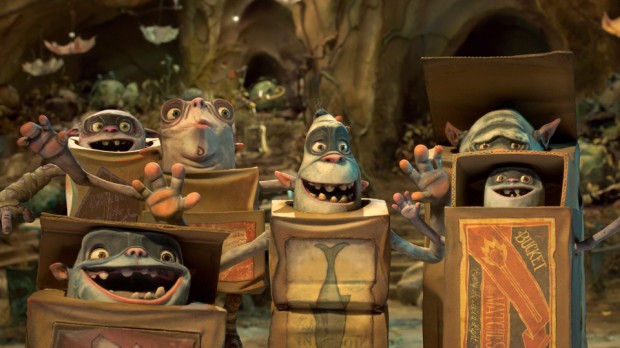

Back in Spring, the Animag editorial team was invited on a delightful, mind-boggling tour of LAIKA studio in Portland, Oregon, where teams of craftsmen, artists and animators were hard at work on the upcoming Focus Features release The Boxtrolls (September 26). According to producer David Ichioka, “Stop motion is not the stupidest, but it is the wackiest possible way to make a film.” Here are some of the wacky things we learned about this neo-Victorian family adventure.
By the Numbers
- 1 week; the average amount of time for an animator to complete 3.7 seconds of footage
- 3.5 inches, the cuff-to-cuff measurement of baby Eggs’ sweater (created on an embroidery machine to produce irregular lines, like a hand-knitted garment). His little socks are only ⅝” long
- 4 scenes per week was the goal for each animator
- 14 different fabrics were used in Lord Portley-Rind’s white hat
- 24 kinds of weeds were created for backgrounds by the greens department
- 55 different sculpts of prop cheeses were made; different scale sizes were needed for wide, medium and close shots
- 56 ½”; the size of the terrifying Mecha Drill vehicle; every joint is articulated for jostling and the prop required its own stage rig
- 30 to 300; the range of crew at work between the beginning of shooting and the height of production
- 1,300 shots required vfx touches, which were accomplished by 50 artists
- 20,000+ props were handmade for the film; the smallest prop is a tiny sewing needle with thread
- 55,000 facial expression pieces were 3-D printed, with the potential for approximately 1 million combinations
- 125,280 individual character poses are needed to create the 87-minute film
The Puppet Department
With different artists creating delicate armature (both for characters and their costumes), hemp hair wigs and intricate costumes, there was a lot to take in.
- This is the first LAIKA film that started with a silhouette lineup of characters (by artist Mike Smith).
- Key influence words were: Fantasy Dickensian world, nervous lines, Ballet Russe, Impressionism.
- Costumes were really pushed for this third film thanks to Deborah Cook’s period-inspired designs including lace created on an embroidery machine and cut-outs, panels and patterns made with a laser cutter.
- European expressionism even factored into the “skin” painting — faces and hands were stylized with blocky colored lines and contrasting areas.
- Mechanical challenges included the villain Snatcher’s belly, which has its own gear for jiggling, the Boxtrolls’ bendy midjoint and the big ballroom scene which required jointed rigs in the ladies’ skirts to create a Gone with the Wind effect.
Rapid Prototyping
The standout feature of LAIKA’s process is the use of color 3-D printing, which they helped the technology company develop. Maquettes are scanned in and rigged in Maya, where CG artists use animatic references to create the range of facial poses needed for each scene — and each face has separate sections for brows, eyes and mouth with the seams removed in post. This film upped the ante on facial detail and internal mechanical complexity. Boxtrolls also required LED glowing eyes and half-heads for when they shrink into their boxes.
- Texture painters used traditional painting techniques in Photoshop to create layering and cross-hatching effects
- Once the library of expressions is available, the stop-motion animators can use reference numbers to create “kits” needed for their scenes
- “Face Librarians” are responsible for pulling the animators’ kits and touching up the pieces by hand to assure color consistency, which can vary in the prints due to humidity and other factors
- Also the first film where background characters occasionally come forward, meaning 3-D prints had to be made for their faces in addition to the background rigged silicon puppets
Tricks of the Trade
In order to accommodate the creative stereo camera angles needed, sets with complex scenes could be separated into sections; although sometimes the animators needed to get creative with step-stools, ladders and un-ergonomic working postures.
- Since much of the film takes place underground or at night, ambient lighting was incorporated into the sets with lamps and furnaces
- Small greenscreen “choppers” were used for complex sets that required the vfx artists to create extensions and background seen through arches, etc.
- Animators worked with side by side stereo camera rigs from Canon that included live monitors with playback feature to quality-check lighting and movement as they work
- The “Tunnel” slide scene’s side angle shots with trolls passing by was a 50/50 practical and vfx sequence
- New School: The Mecha-Drill’s flames are actually a looped video on an iPad inside the furnace’s mouth
- Old School: The animators on the sewer scene used an old trick of a rotating plat of rippled glass above an up-light to create moving water and wavy background light
Quote of the Day
During an informative lunch with directors Graham Annable and Anthony Stacchi, Anthony gave the best summary of the film’s dichotomy of the above-ground, cheese-filled world of oppulence and color and the dreary night world of the trolls and their antagonist: “The Boxtrolls is like if Terry Gilliam did Oliver Twist.”
Animation Magazine will have a feature story on The Boxtrolls in the October 2014 issue. In the meantime, follow along on social media: TheBoxtrolls.com, on Twitter with #TheBoxtrolls and @TheBoxtrolls, on Facebook at facebook.com/theboxtrolls, or on Instagram @TheBoxtrolls






















 Win a Funko X Lilo & Stitch Prize Pack!
Win a Funko X Lilo & Stitch Prize Pack!

